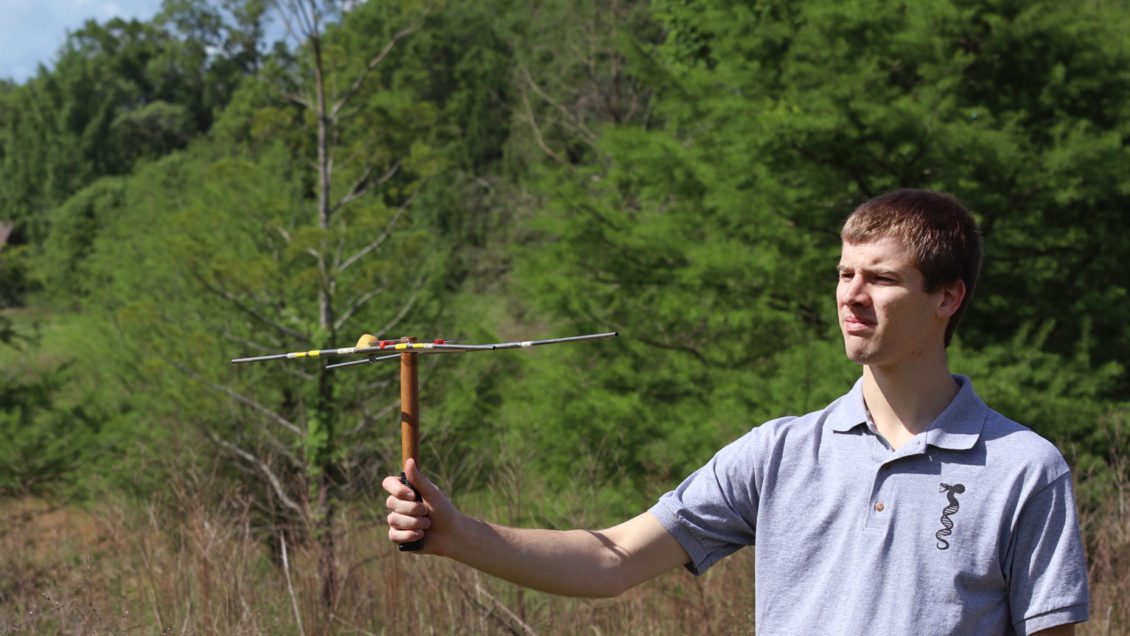CLEMSON, South Carolina — Clemson University College of Science graduate student researcher Rhett Rautsaw is one of only five scientists in the world to receive the 2019 BioOne Ambassador Award, which recognizes early career authors working to communicate the importance and impact of their research to the public.
Rautsaw’s paper, titled “Stopped Dead in Their Tracks: The Impact of Railways on Gopher Tortoise Movement and Behavior,” was published in the journal Copeia in March 2018.
Here is BioOne’s list of the five winners in alphabetical order:
- Mack W. Frantz, nominated by the American Ornithological Society;
- Claudia Hermes, nominated by the Editor in Chief of Écoscience;
- Jennifer Hofmeister, nominated by the American Malacological Society;
- Rhett M. Rautsaw, nominated by the American Society of Ichthyologists and Herpetologists; and
- Lucrecia Souviron Priego, nominated by SEO/Birdlife.
Rautsaw’s research has focused on understanding and testing how railways impact the movement and behavior of gopher tortoises. Gopher tortoises, which are native to the southeastern United States, are threatened with extinction because of habitat destruction and fragmentation. They frequently are found trapped in railways.

“To test if railways contribute to habitat fragmentation for gopher tortoises, my colleagues and I first used radio telemetry to track the movement of tortoises around railways,” said Rautsaw, who is a doctoral student from Laura, Ohio, in the department of biological sciences. “We compared the movement patterns of these tortoises to what we might expect if the railways were not there and found that railways are a significant barrier to movement.”
Rautsaw’s next goal was to determine if gopher tortoises were able to cross railways at all and whether they changed their behavior to cope with the presence of railways. To do this, he and his team placed tortoises into a railway and monitored their behavior for an hour. Out of 24 tortoises, none was able to cross over the rail or escape entrapment. Together, these results demonstrated the impact railways have in restricting gopher tortoise movement and contributing to both habitat fragmentation and mortality by entrapping tortoises.
“With the problem identified, we took the next step to find a solution,” said Rautsaw. “We dug trenches underneath the rails and between the railway ties. The trenches not only provided a path for tortoises to cross from one side to the other, but also an escape route for tortoises that became trapped. Using game cameras, we monitored the use of the trenches and found that they were used extremely frequently, facilitating movement both across and out of the railways.
“Although my work focused on gopher tortoises, all turtles and tortoises are vulnerable to entrapment in railways,” Rautsaw added. “Many other animals are also heavily impacted by railways, including toads, salamanders and even large animals like moose and bear. A whole new field of ecology has spawned to study and tackle these issues: railway ecology. Although wildlife still faces many other threats, our study on gopher tortoises provides a simple solution for turtles and tortoises that we hope will be widely implemented.”
“Rhett came into this project with an open mind, took ownership, added many creative experiments to thoroughly test our hypotheses and was very successful. Rhett’s goal is to help protect species and communicate his science to the landowners so that they can manage their resources.” said Chris Parkinson, Rautsaw’s adviser and professor of biological sciences. “Additionally, Rhett is a born leader, he recruited and mentored four undergraduates research students on this project and all have matriculated to graduate and or professional school.”
BioOne is a nonprofit publisher that aims to make scientific research more accessible through a growing portfolio of products and services, including its full-text aggregation BioOne Complete. BioOne sees sustainable scholarly publishing as an inherently collaborative enterprise connecting authors, publishers, professional societies, academic institutions, libraries and research funders in the common goal of maximizing access to critical research.
“This award means a lot to me in particular because it shows an appreciation not only for my research, but also for my ability to communicate science,” Rautsaw said. “I think this work is truly important because it has large implications for conservation. Even a railway company in Florida has contacted me about potentially implementing the trenches to help out gopher tortoises.”
Now in its second year, BioOne’s Ambassador Award was created to spotlight rising scholars in their specialties and generate a wider interest in recent scientific research from our publishing partners. Each winner receives a $1,000 award and wide dissemination of their research.
Get in touch and we will connect you with the author or another expert.
Or email us at news@clemson.edu

